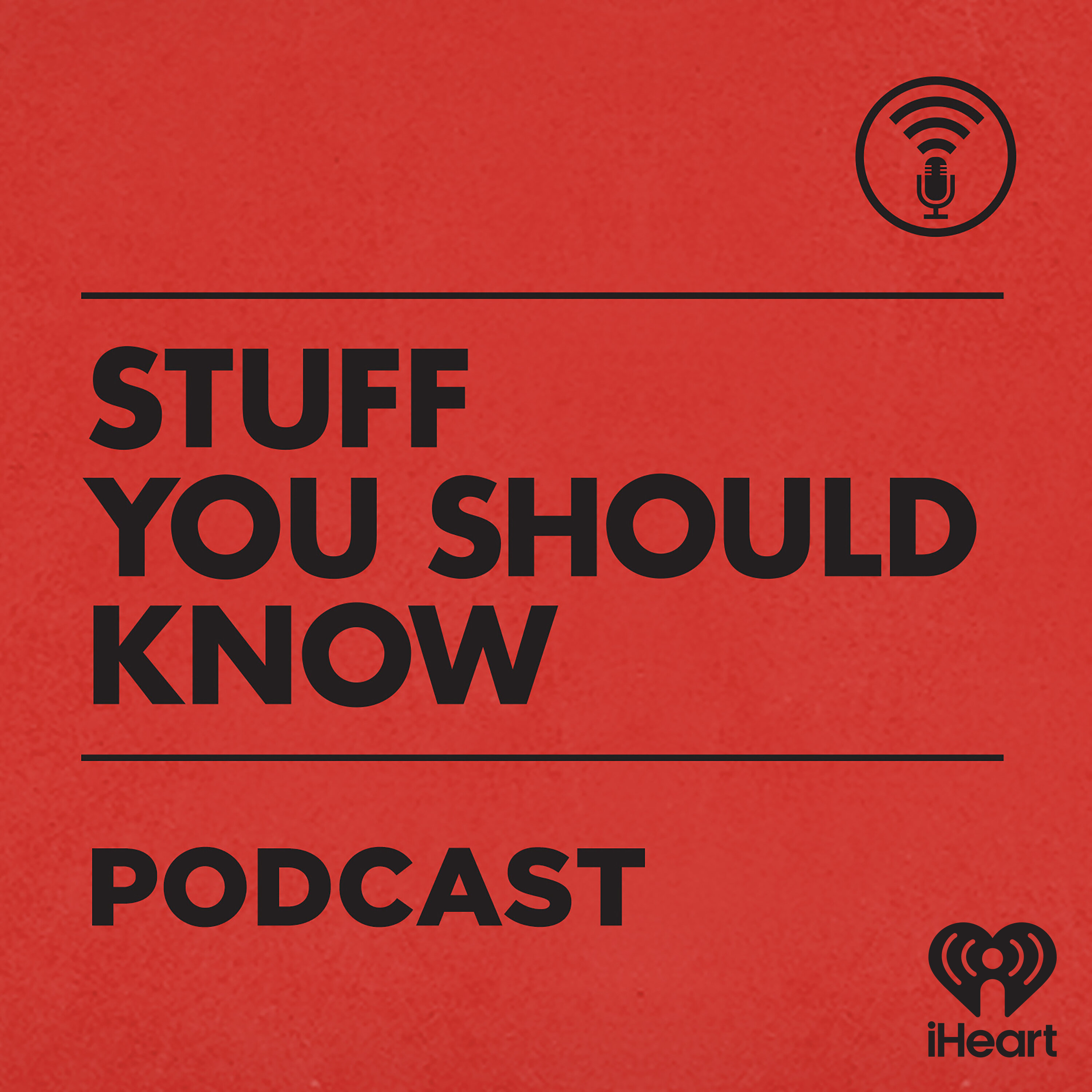Short Stuff: Yakhchāls - Ancient Fridges
If you lived in ancient Persia, you could do a lot worse in trying to cool things down than by building a yakhchāl. Today we break down how the early fridges worked.
See omnystudio.com/listener for privacy information.
Press play and read along
Transcript
Speaker 1 This is an iHeart podcast.
Speaker 2 Want Black Friday prices without the crowds? Lowe's gets it. Shop their early Black Friday deals and beat the rush.
Speaker 2 $99 is all you need to grab a select seven-foot pre-lit artificial Christmas tree for the holidays. And don't sweat what gifts to get, Dad.
Speaker 2
They have up to 40% off select tools and accessories going on now. That's how Lowe's celebrates Black Friday early.
Selection varies by location while supplies last.
Speaker 3
Hey, and welcome to the Short Stuff. I'm Josh, and there's Chuck, Jerry sitting, and Freak Dave.
And so this is Short Stuff, the How Do You Say This Again edition.
Speaker 2 Yeah, I'm going to say it's pronounced spelled Y A K H,
Speaker 2 you know, as most words are.
Speaker 2 C-H-A-A-L.
Speaker 2 I'm going to say Yakals.
Speaker 3 I'm going with the straight ahead Yakchals.
Speaker 3 All right.
Speaker 3 Okay.
Speaker 3
So you say it your way throughout. I'll say it my way.
And I'm sure I'll inevitably unconsciously start saying it your way.
Speaker 3 We'll see.
Speaker 2 But what we're talking about is the promise from our refrigeration episode a little bit more on these ancient,
Speaker 2 basically ancient refrigerators or cooling systems that were found across ancient Persia at least as old as 400 BC. This is modern day Iran.
Speaker 2 And these are places where, believe it or not, the climate enables freezing of ice
Speaker 2 when you would not think you should be able to freeze ice.
Speaker 3
Yeah, it's pretty amazing. And apparently, still today in Iran, Afghanistan, and Tajikistan, Tajikistan, yeah, I said it right the first time.
They call the refrigerators Yakchals,
Speaker 3 which is how I would say it if I were in Iran. But that's the name for the fridge, which means that at some point, someone in Iran has gone into a store and said, you got a smeg yak chow?
Speaker 3 Yeah, exactly.
Speaker 2 And these have been the fascination of like everyone from engineers to historians to physicists over the years because they're just so
Speaker 2 kind of confusing in how they actually work.
Speaker 2 And I'm still not entirely sure how it works. It seems to be a little magic involved.
Speaker 2 One thing I know goes a long way toward keeping this ice.
Speaker 2
And we got to say, some of this ice is mined from the mountains and brought down and preserved. Some is made on site.
We'll get to that.
Speaker 2 But one big factor is the insulation of the structure itself, which is made from
Speaker 2 a mortar called sarouge.
Speaker 3 So is that how you're saying it?
Speaker 2 Yeah, sand, clay, egg whites, lime, goat hair, and ash.
Speaker 2 Quite a mixture.
Speaker 3 Some of these were several meters thick. Some of these yak chows were.
Speaker 3 But there was a study, we got some of this information from the engineering firm Max Fordham, and they did an analysis in 2018 of Yak Chows and just how effective they might have been.
Speaker 3 And they found that the walls of a Yak Chow
Speaker 3 had the same insulative properties as a wall of concrete three inches thick, surrounded by a one-foot thick wrapping of styrofoam insulation. That's how effective these things were.
Speaker 2 Sand, clay, egg whites, lime, and goat hair, and ash.
Speaker 3 I was going to say like the secret is egg whites, but I don't know. You throw goat hair in there and
Speaker 3 who knows what the secret is. I think the secret is the whole thing together, the whole Seruj
Speaker 3 mixture.
Speaker 2 Yeah, probably so.
Speaker 2 So I mentioned that sometimes the ice was brought in from the mountains and kept there throughout the year, but usually what would happen is
Speaker 2
they would make ice. They would bring in water.
They would divert water from an aqueduct through these underground water channels called canats.
Speaker 2 And they would channel them to the north side of this wall. It's another thing we haven't mentioned yet is they have these very, very high walls that act as shade for these channels
Speaker 2 to keep
Speaker 2 the wind off of it because stuff isn't going to freeze as fast if it's moving. So to keep the water still and to keep it cooler away from that sun.
Speaker 3 Yeah, and so the channel has a little diversion into a trench or a pit or like a very shallow like rectangular pond usually. And
Speaker 3 they'll divert water in there to fill it up and then they let it freeze overnight.
Speaker 3 Over the course of a few nights, it'll continue to freeze and freeze and freeze in layers.
Speaker 3 And what they're taking advantage of, you know, like when it snows and then the temperatures heat up and all the snow melts, but there's a little pile of snow like in a shaded corner of your yard that never gets direct sunlight.
Speaker 3 Yeah. And it just takes forever to melt.
Speaker 3 They're taking advantage of the same thing. They're building
Speaker 3 that big old wall to keep it shaded and to just let this ice grow and grow and grow.
Speaker 3 And then once it reaches, I think, 50 centimeters, which is like about a half a meter thick, then they'll cut it into blocks and they put it in the yak chow and they store it
Speaker 3
through summer. Like this stuff will stay frozen for an entire summer.
So in that sense, these yak chowls are built to store cold throughout the course of a year.
Speaker 3 Even when the summer comes around, still cold.
Speaker 2
Yeah, another way that helps us out is that dome shape. It's not domed because they like domes, even though domes are nice.
It's conical because that optimizes what's called the solar chimney effect.
Speaker 2 That's when you create a convection current, letting that heat go up, up, up, and out through these openings at the top and bringing in that cool air from the bottom.
Speaker 3 They also have wind catchers that they call bajirs,
Speaker 3 and they actually take wind and direct it downward into the Yakchal dome.
Speaker 3 And so the air that hits it is cooled by that ice, and the air that's not cooled by it or cooled enough.
Speaker 3
Like you said, that chimney effect takes it up along the curved sides toward the hole in the top. And it says, see you later.
Don't come back.
Speaker 2 That's right.
Speaker 2 And that feels like a good time for a break. And we'll come back and talk about what the heck they're doing with all this ice right after this.
Speaker 2 Attention, parents and grandparents. If you're looking for a gift that's more than just a toy, give them something that inspires confidence and adventure all year long.
Speaker 2 Give them a Guardian bike, the easiest, safest, and number one kids bike on the market.
Speaker 3 Yeah, with USA-made kids-specific frames and patented safety technology, kids are learning to ride in just one day with no training wheels needed.
Speaker 3 It's why Guardian is America's favorite kids' bike and the New York Times and Wirecutters' top pick three years in a row.
Speaker 2
That's right. My daughter has a Guardian bike and she loves it.
And that thing was really easy to put together.
Speaker 2 And get this: this holiday season, Guardian is offering their biggest deal of the year: over 40% in savings on all bikes, plus $100 in free accessories.
Speaker 2 Guardian bikes have become one of the most sought-after gifts of the season, and inventory is going fast, so don't wait. Join over a half a million families who've discovered the magic of Guardian.
Speaker 2 Visit guardianbikes.com to shop now.
Speaker 3 Living with a rare autoimmune condition comes with challenges, but also incredible strength, especially for those living with conditions like myasthenia gravis or MG and chronic inflammatory demyelinating polyneuropathy, otherwise known as CIDP.
Speaker 3 Finding empowerment in the community is critical.
Speaker 2 That's right.
Speaker 2 And in the latest season of Untold Stories, Life with a Severe Autoimmune Condition, a Ruby studio production in partnership with Argenix, host Martine Hackett explores what it means to reclaim your identity, discover resilience, and cultivate self-advocacy.
Speaker 3 From the frustration of misdiagnosis to the small victories that fuel hope, every story told is meant to unite, uplift, and empower.
Speaker 3 And that inspires us all to take one step closer to being a better advocate and seeing life from a different point of view.
Speaker 2 So if you or a loved one are living with an autoimmune condition, find inspiration along your path.
Speaker 2 Listen to Untold Stories, Life with a Severe Autoimmune Condition on the iHeartRadio app, Apple Podcasts, or wherever you get your podcasts.
Speaker 2 All right, so they're making ice, they're preserving ice. What are they doing with all this ice? One of the things they're doing is using it as a refrigerator.
Speaker 2 You know, they'll store food in there that they don't want to go bad and just using it as a cold house.
Speaker 2
They will also just use the ice to eat in a treat. They have something called faluda over there.
It's a Persian traditional dessert. It has thin vermicelli noodles made from cornstarch.
Speaker 2 And then you mix that up with a little semi-frozen syrup of sugar and rose water, and then serve it up with a little lime juice and maybe some ground pistachios, and it's like a little Persian icy.
Speaker 3
That has to be better than it sounds, don't you think? Oh, I think it sounds great. I think the pistachios are what are throwing me off.
Oh, yeah. You don't like pistachios or? I do like pistachios.
Speaker 3
It just they don't seem to go with the rest of the ingredients. But like I said, I'm sure it's delicious.
I mean, it's a traditional Persian dessert. It's got staying power.
So
Speaker 3
who am I to question faluda? Exactly. I bet it's delicious.
One of the cool things about this is that yak chals, I mean, and there's some still around.
Speaker 3 I think there's one in Kerman, Iran, that's about the size of a five-story building. So you would think, of course, obviously this was reserved for royalty.
Speaker 3 You would be dead wrong because not only were yak chals open and available to the public, there were some that people just built for their houses that were of private use as well.
Speaker 2 Yeah, for sure. They would make those
Speaker 2
delicious faluda. They would make sherbets and preserve them.
And then nuts. fruit and ice and they would put them on a donkey and go sell them at market and stuff like that.
Speaker 2 They would sell ice directly from those places sometimes.
Speaker 2 And, you know, one of the things they're also taking advantage of is the greenhouse effect.
Speaker 2 You know, the earth is going to stay fairly warm at night because of the greenhouse effect, trapping those gases in the atmosphere.
Speaker 2 But if it's low humidity, and if it's a really clear night, that effect is going to be weaker and that heat can dissipate and disappear more readily.
Speaker 2 And so that's when they discovered, like, hey, we can make these little thin layers of ice and kind of build, you know, day by day, night by night on these clear, low humidity nights eventually to get, you know, some pretty significant ice.
Speaker 3
And once they figured that out, someone said, go get the donkey. Yeah, exactly.
It's time to sell some sherbet.
Speaker 2 And harvest some goat hair.
Speaker 3 One other thing I saw in that Max Fordham analysis, they figured out that they could make about what would be equivalent to three million ice cubes a season. Wow.
Speaker 3 Yeah, which is a lot, but they were like, you'd think it'd be more. And I was like, it seems pretty good to me, especially in 400 BC, you know?
Speaker 2 Yeah, it depends on how big those cubes were. Were they big fancy cocktail cubes? That's a lot more ice than an ice nugget.
Speaker 3 That's right. You're absolutely right.
Speaker 3
I expect that they're probably all donkey head-size. So 3 million donkey head-size ice cubes.
That's big. Think about the poor donkey that had to cart those around.
Speaker 2 I know. No fun.
Speaker 3 You got anything else?
Speaker 2 Yeah, I mean, these went away, obviously, because of modern refrigeration came on the scene.
Speaker 2 And also, one thing that was happening was they were making this ice kind of out in the open, and a lot of it would get contaminated with dust, and it wasn't like the healthiest ice in the world.
Speaker 2 And so that combined with modern refrigeration refrigeration coming along, they're like, maybe we should just not have these much anymore.
Speaker 2 But like you mentioned, there is one still around at least in Kerman.
Speaker 2 And there are groups there that are trying to preserve this way of life and at least keep it,
Speaker 2 you know, not like a chief refrigerating method, but like, hey, we can't lose
Speaker 2 our culture. And so let's work to take some of these old ones and restore them at least, even if only for like museum and touring purposes.
Speaker 3 For sure. But also there's a lot to learn from them, especially when we're trying to advance like passive cooling and other things that require less energy to cool things down.
Speaker 3 Yak challs are something to turn to and say, How do we do this? And someone says, Go get the goat here.
Speaker 2
Yeah, that's right. Get some egg whites too.
No one likes those.
Speaker 3 What do we do with all these yolks? Yeah.
Speaker 3 Well, I think that's it for short stuff, right, Chuck?
Speaker 2 I think so.
Speaker 3 Well, that means short stuff is it.
Speaker 1 Stuff You Should Know is a a production of iHeartRadio. For more podcasts from iHeartRadio, visit the iHeartRadio app, Apple Podcasts, or wherever you listen to your favorite shows.



